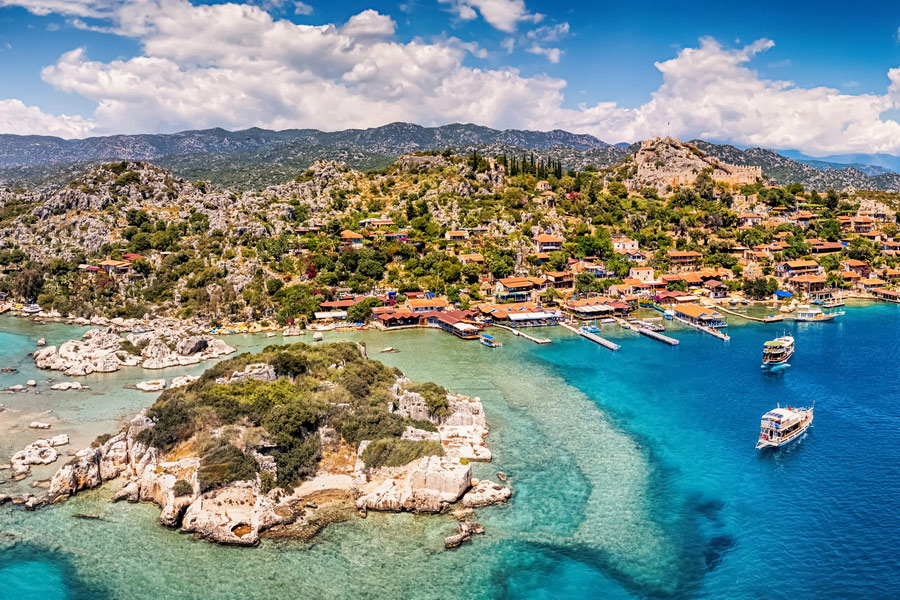With more than 300 days of sunshine annually, the Mediterranean Region of Turkey (Türkiye) stretches from Antalya to Hatay, housing world-class beaches, historic sites and boisterous port cities. Celebrated as the Turkish Riviera, the region is a top destination for swimming, sunbathing, yacht tourism, cruise tours in Turkey and water sports, attracting visitors year-round because of its Mediterranean climate.
At its heart lies Antalya, the vibrant Capital of Tourism of Turkey, which features stunning Konyaaltı (Konyaaltı Plajları) and Lara beaches, iconic landmarks such as the Yivli Minaret (Yivliminare Camii or Alaaddin Camii or Ulu Camii), and nearby ancient wonders including Perge (Perge Harabeleri), Aspendos (Aspendos Antik Kenti) and Side.
Located south of the Taurus Mountains, the region is additionally sometimes referred to as the Turquoise Coast and includes seaside gems such as Alanya, Kaş, Kekova, and Kemer, and mountain cities like Termessos and Arikanda in ancient Lycia.
Further east, Turkey's Mediterranean cities like Mersin, Adana, İskenderun and Antakya display Turkey's Mediterranean culture, agriculture, industry and historical depth, from Roman ruins to early Christian heritage. Known for its citrus groves, caves, mediaeval castles and traditional cuisine, the Turkish Mediterranean remains one of the best places to visit in Turkey for both relaxation and exploration.
Mediterranean Tours
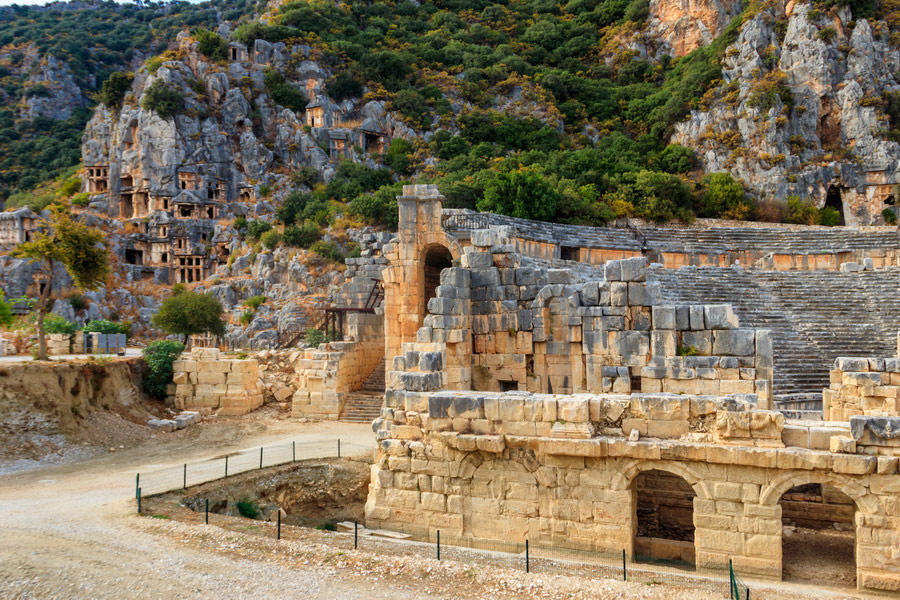
On the azure shores of the Turkish Mediterranean, golden sunsets glow over old Roman ports, where fancy yachts with silky sails rest. This is the daily rhythm of life along the Turquoise Coast, where Turkey’s southern edge unravels through history-rich cities, forested bays and sun-kissed sandy Mediterranean beaches.
Antalya, the so-called pearl of the Mediterranean, is the pulsating heart of the region and a gateway to both leisure and legend. Its ancient Roman harbour in Kaleiçi remembers stories of merchants and sailors, while Düden Waterfalls (Düden Şelalesi) go directly into the sea. Beyond the city, Aspendos attracts visitors with a Roman theatre so preserved, it still hosts performances, and Perge reminds you of a once-thriving Hellenistic city.
In the west, Fethiye’s natural beauty marries its deep heritage: paragliders leap from Babadağ mountain over the aquamarine curve of Ölüdeniz Beach (Ölüdeniz Plajı) ; stone sarcophagi rest under citrus trees; boats drift over the sunken ruins of Kekova. Nearby Kaş and Kalkan are top destinations for both tranquillity and adrenaline with scuba diving, canyoning or a long, lazy dinner of meze and grilled fish opportunities.
East of Antalya, Side houses seaside temples and Roman roads; Alanya stretches its beaches around a hilltop Seljuk fortress. Inside the Mediterranean region of Turkey, the Flames of Chimaera is a natural fire caused by escaping gas from the ground, in Olympos and Çıralı, while orange groves bloom around the Lycian tombs of Myra.
Heading east, the Turquoise Coast begins to shift into something older and wilder with Adana’s spicy kebabs, the ancient mosaics of Antakya and extraordinary ruins of Anamur. From luxury Mediterranean resorts in Belek to hiking the Lycian Way (Likya Yolu) or sailing on a Blue Cruise, Mediterranean Turkey tours guarantee an all-encompassing mix of culture, temperature, and shoreline.
Best Time to Visit the Mediterranean Region

The Best time to visit the Mediterranean Coast of Turkey is June and August. This is the season of bright sun, long days and joyfully wild coastline. Antalya, Fethiye, and Kaş awaken with beach clubs, open-air festivals, and buzzing nightlife. It’s the perfect time to hop on a sailing tour across the turquoise waters, stopping at hidden coves, sun-kissed islands, and charming harbours. Cruising along the coast from Bodrum to Olympos, you can swim in secluded bays, dine on fresh Mediterranean food in Turkey in tiny fishing villages and feel the Mediterranean breeze under the stars.
In autumn, from September to mid-October, the sea is still warm, the crowds thin out and the golden hour light makes the landscape even more striking. This is the best season for hikers and nature lovers: the Lycian Way is more manageable, and Green Canyon reveals its calm, contemplative beauty. Turkey's Mediterranean cities, such as Side and Alanya, become more accessible, and it’s a great time for jeep safaris and cable car rides to Mount Tahtalı (Tahtalı Dağı).
In winter the Mediterranean cities don’t shut down. With mild temperatures and occasional rain, it's a quieter time to visit places like the old town of Antalya or ancient ruins along the coast. The low-season charm and cheaper prices appeal to those in search of solitude, Turkey's Mediterranean culture and photography.
Spring, especially April to early June, delivers blooming nature, warm seas and endless activity options. The waterfalls are full, trails are green and archaeological sites like Olympos or Termessos are surrounded by wildflowers and blooming wisterias.
Uncover the Charms of the 8 Provinces in Turkey’s Mediterranean Region
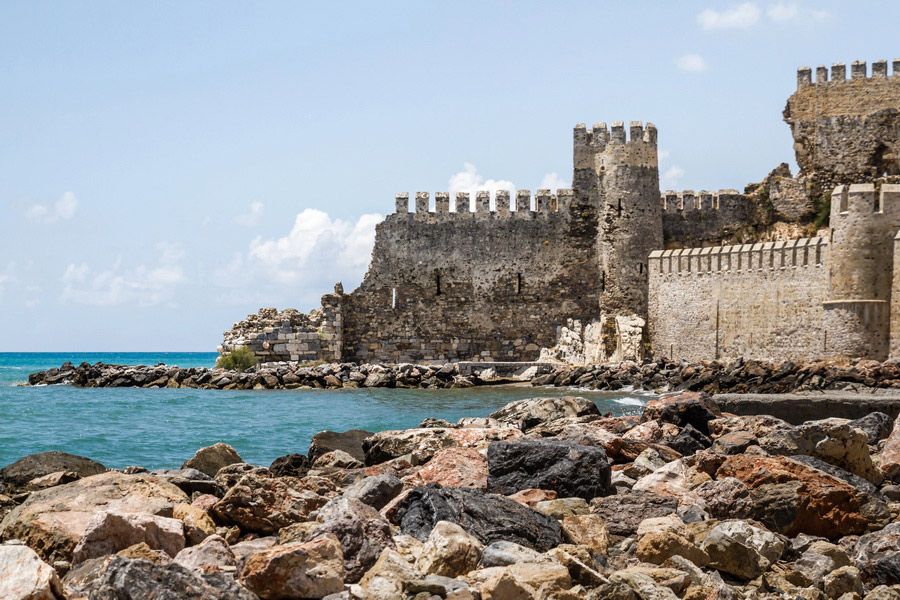
Stretching from the banks of the Levantine Sea to the fertile Çukurova Plain and the heights of the Taurus Mountains, the region holds eight diversified provinces with varied Turkey Mediterranean history, habitat, cuisine and culture. Antalya province, the pride and joy of Mediterranean holidays in Turkey, is renowned for its 657 km of coastline dotted with ancient Turkey Mediterranean cities, sandy beaches and world-class Mediterranean resorts. Mersin has 321 km of seashore and an interior of rugged peaks and fertile plains. Home to Tarsus, this province is the birthplace of Paul the Apostle, featuring highland meadows and citrus groves along the Turkey Mediterranean coast.
To the east, steeped in culinary traditions, Adana rises as the heart of the Çukurova Plain and is surrounded by Taurus, Mediterranean Coastal and Volcanic mountains. The city of Adana itself dominates the province and is an essence of Mediterranean food in Turkey. Hatay, Turkey’s southernmost province, celebrates a distinct cultural mosaic, with Antakya (ancient Antioch) and İskenderun showcasing the region’s complex history and its distinct Levantine cultural identity. Osmaniye, formerly part of Adana, is quieter but historically nuanced, with sites like Karatepe and Toprakkale Castle reflecting the depth of Turkey's Mediterranean history.
To the north, Kahramanmaraş harmonises Mediterranean and continental climates, with its plains, mountains and the Ceyhan River defining its geography. Inside the region, Isparta and Burdur, both part of Turkey’s Lakes Region, deliver alpine lakes like Salda and Burdur, along with roses, carpets and apple orchards, adding a rural dimension to Mediterranean Turkey travel.
Explore the History of the Turkish Mediterranean Region
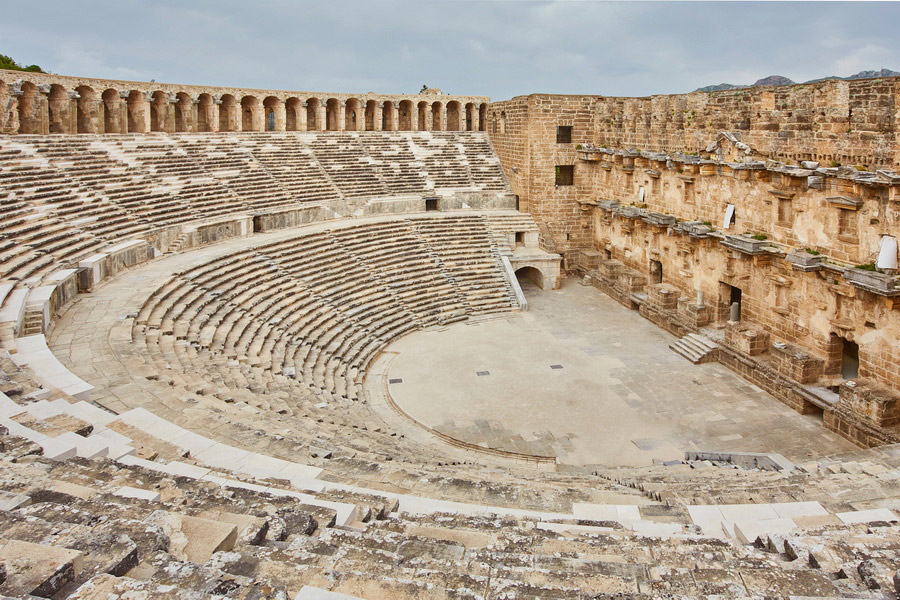
The history of Turkey’s Mediterranean region begins in ancient times, where traces of human life stretch back to the Palaeolithic era, as displayed in the Karain Cave near Antalya, inhabited around 500,000 years ago. As early as the 15th century BC, Adana and its surroundings were ruled by the Hittites, followed by a succession of powerful empires of Assyrians, Persians, and Macedonians, until Alexander the Great’s sweeping conquest in 333 BC.
By the 2nd century BC, the Lycian civilisation flourished across what is now southwestern Turkey. Distinguished by their unique confederation system, called the Lycian League, they developed one of the first democratic assemblies in recorded history, influencing later constitutional models, including that of the United States.
Antalya, founded by King Attalos II of Pergamon around 150 BC, became a vital Roman port. The Roman influence endures in monuments such as Hadrian’s Gate (Aspendos Theatre) and the Aspendos Theatre (Aspendos Antik Tiyatrosu). Later, Byzantine, Seljuk and Ottoman rulers scaled their own marks onto the cityscape. In the Acts of the Apostles, Paul and Barnabas’s journey through Attalea marks another early Christian trace in the region.
Mersin, settled in the Neolithic age, passed through Assyrian, Persian, Roman, Byzantine, Arab and Armenian hands before falling to the Ottomans in the 16th century. Its transformation from a coastal village to a cotton-exporting centre during the Industrial Revolution cemented its role as a regional economic engine.
Adana, named after Adanus, the son of the Greek god Uranus, faced Hittite, Persian, Roman, Islamic, and Crusader invasions until Ottoman consolidation under Sultan Selim I in 1517. Hatay, home to ancient Antioch, served as a cultural crossroads on the Silk Road and only joined the Republic of Turkey in 1939 after a period of French control.
Plan Your Dream Holidays in Turkey’s Mediterranean Region

Turkey’s Mediterranean Region guarantees an ideal balance of Turkey's Mediterranean history, nature and leisure, with its vast archaeological heritage along the turquoise coastline delivering the greatest Mediterranean holidays in Turkey. The region is home to some of the most important ancient settlements in Anatolia. From the UNESCO Tentative List site of Anazarbus near Adana to the port city of Andriake in Antalya, history, culture and adventure run deep here.
Timeless History & Ancient Ruins
The Lycian capital, now a UNESCO world heritage site, Xanthos, the mountain fortress of Termessos within Güllük Dağı National Park; the ancient Turkey Mediterranean cities of Myra, Side, and Aspendos; and early Neolithic sites like Hacılar in Burdur uncover thousands of years of human activity. Antalya alone hosts numerous ruins, including Phaselis, Olympos, Ariassos, and the Church of St Nicholas. Mersin contributes with sites such as Corycus (modern-day Kızkalesi), Elaiussa Sebaste, and Mamure Castle, while Hatay preserves its Hellenistic past with Antioch and nearby Seleucia Pieria. Archaeological highlights like Kibyra, Tell Tayinat, and Domuztepe enrich the region more.
Turquoise beaches & crystal-clear waters
Stretching over 1,600 kilometres, the Mediterranean coastline is also known as the Turkish Riviera and is packed with world-class Turkey Mediterranean beaches. Antalya’s famous Lara and Konyaaltı beaches have easy access to the city, while the Olympos-Çıralı coast, Adrasan and Phaselis combine ancient ruins with peaceful coves. Alanya’s Cleopatra Beach, Kemer’s scenic lagoons, and Kaş’s Limanağzı and Kaputaş Beaches provide assorted options of sandy shores. Mersin’s coastline features some of the cleanest waters on the Riviera, particularly around Kızkalesi. Hatay’s 14 km-long Çevlik Beach, located near the Titus Tunnel, is one of the longest and most historical beaches of Mediterranean Turkey. Even Adana, with a shorter coastline, ensures remarkable seaside experiences.
Cruising & Yachting
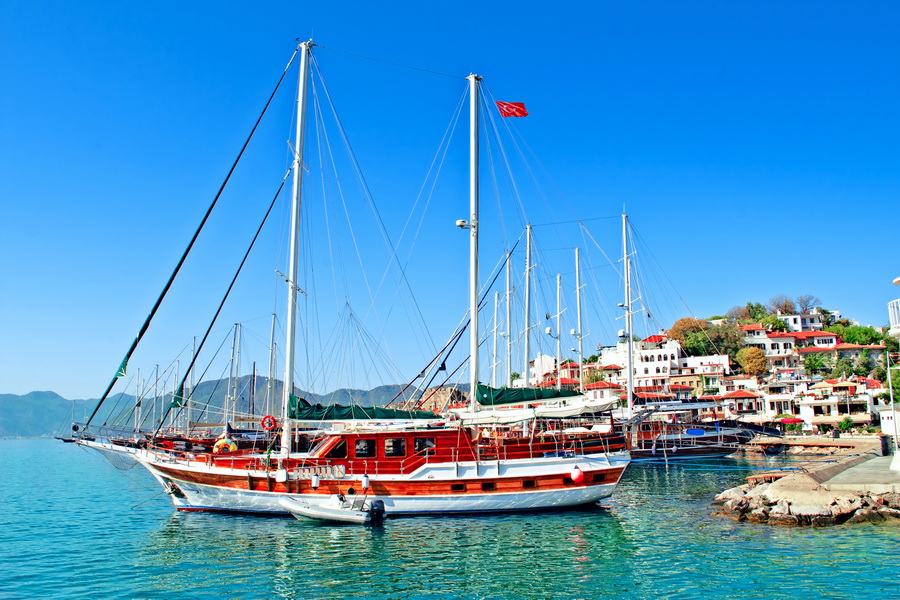
Cruising and yachting are key Mediterranean Turkey attractions in the region, with popular routes including Fethiye to Kekova and Bodrum to Marmaris, often stopping at Göcek’s Twelve Islands, Dalyan’s Lycian tombs and the undisturbed inlets of Ölüdeniz. Mediterranean cruises in Turkey join coastal scenery, historic landmarks, thermal springs, and underwater ruins. Ports like Kaş, Demre and Mersin serve as launch points for various boat tours and sailing charters, making it easy to access remote beaches and ancient harbours.
2 Seasons in 1 Day
With the region's diverse geography, it is possible to experience two seasons in a single day. Antalya is mostly known for its turquoise beaches, lacking any snowy peaks, yet within the relatively short distance of under 45 minutes, the Saklikent Ski Resort (Saklıkent Kayak Merkezi) creates a double feature for winter. Spend the morning swimming in the Mediterranean, and by the afternoon, you could be skiing or snowboarding down a mountain slope. At 2,400 metres high in the Beydagi Mountains, Saklikent is isolated from the hustle and bustle of city life and gives a winter resort vibe with its modestly sized ski slopes, lifts and mountain chalets.
Marvel at Nature's Wonders and Delight in Outdoor Activities
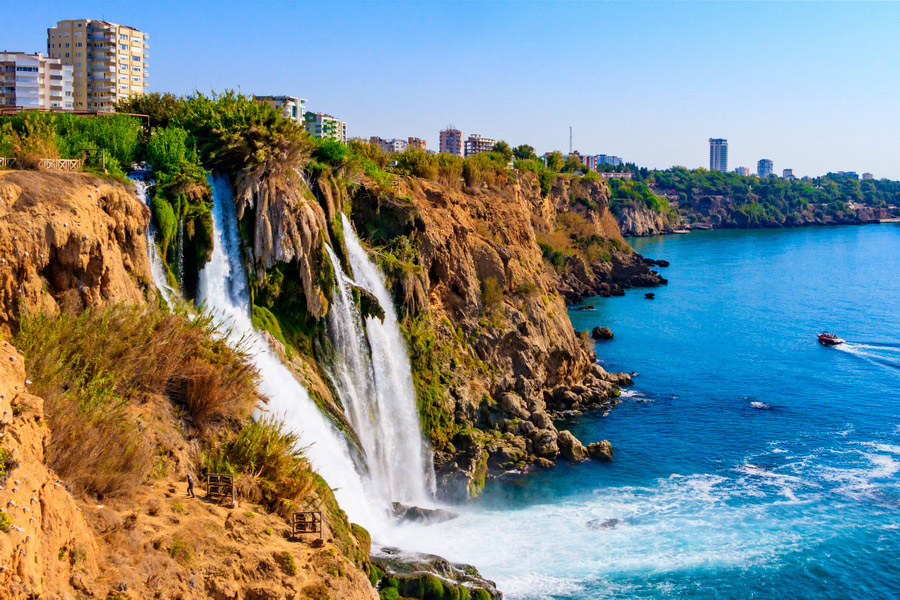
This sunny coast is a powerhouse of natural Mediterranean Turkey attractions and outdoor experiences, stretching along a 1,000-kilometre coastline backed by the Taurus Mountains. The best places to visit in Mediterranean Turkey are Patara Beach in Antalya, one of the longest beaches in the Mediterranean at 18 km, with white sands, turquoise waters and a vital nesting ground for sea turtles. Kaputaş Beach, stuck between massive cliffs, is accessed via a staircase and known for its vivid turquoise water, earning the coast the nickname “Turquoise Coast.”
Antalya features several must-see waterfalls: Düden Waterfalls (Upper and Lower) are within city limits, with the Lower Düden dropping 40 metres into the sea, creating striking visuals, especially from Gençlik Parkı. Manavgat Waterfall (Manavgat Şelalesi), near Side, is another easily accessible natural site known for its wide, low cascade.
Adventurers can head to Göynük Canyon (Göynük Kanyonu), Turkey’s first and largest adventure park. Here, visitors can zipline across lakes, hike suspension bridges and enjoy guided canyoning safaris through sculpted rock formations and unspoiled river paths. While inland, Tahtalı Mountain, peaking at 2,365 metres near Kemer, holds Europe's longest cable car, Olympos Teleferik. Besides scenic views, Tahtalı also supports paragliding and hiking routes to Beycik and Çukuryayla, ideal for trekking and mountain biking. Beydağları National Park (Beydağları Sahil Millî Parkı), where Tahtalı is located, enriches this setting with dense forests and biodiversity.
The region’s terrain also accommodates long-distance trekking via the Lycian Way and Pisidian Trail, both rich with ancient ruins and coastal panoramas. Köprülü Canyon National Park (Köprülü Kanyon Milli Parkı), 49 km northeast of Antalya, is another outdoor hotspot. Its 14-km-long canyon, bordered by cliffs up to 100 metres high, supports rafting, camping, and visits to Roman-era Selge, showcasing remains like a theatre and temples.
For maritime exploration, boat trips from Antalya, Kaş or Demre lead to coves, islands, and ancient sites like Phaselis, Olympos, and the Sunken City of Kekova near Demre. Kekova, adjoining the Lycian Way, grants snorkelling and sailing experiences, depicting views of submerged ruins. Yanartaş (Chimaera), near Olympos, presents an unusual natural sight: eternal flames releasing from the rocky mountainside.
Green Escapes: Ecoregions and Sustainable Destinations
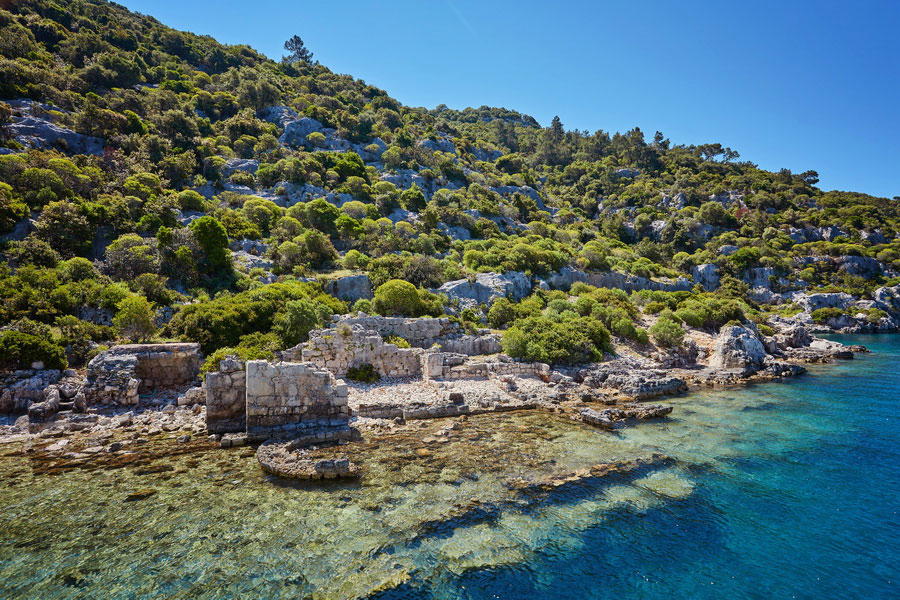
Ecoregions
The Turkish Mediterranean Region lies within the Palearctic realm, the largest biogeographic realm on Earth, which covers Europe and East Asia. The Aegean Sea & East Mediterranean Mixed Forests bioregion includes seven ecoregions, stretching along approximately 49.5 million hectares. These habitats host a convergence of Mediterranean, Euro-Siberian, and Irano-Turanian flora and feature landscapes from high mountains to low plains. Meanwhile, marine biodiversity along the Turkish Mediterranean coast remains poorly studied. Invertebrate groups like annelids, arthropods and molluscs are better researched than lesser-known groups like myxozoa and xenacoelomorpha.
Cittaslow
The Turkish Riviera additionally celebrates sustainable tourism models, such as the Cittaslow network, promoting slower-paced, environmentally friendly destinations. Eğirdir in Isparta Province is a prime Cittaslow city, centred around Lake Eğirdir (Eğirdir Gölü). The area supports eco-activities of birdwatching, endemic plant observation, hiking, paragliding, camping and various water sports. The landscape includes apple and peach orchards and is known for its seasonal colour changes. Yalvaç, another Cittaslow destination in the western part of the region, supports a tranquil lifestyle and environmental sustainability. Finike in Antalya Province also belongs to the Cittaslow network, combining citrus agriculture with nature-focused tourism and a commitment to preserving the local ecosystem and culture for top-notch Mediterranean Turkey travel.
Major Islands
Although Turkey’s Mediterranean coast isn’t as island-dense as its Aegean side, it still includes notable islands such as Kekova, famous for its sunken city ruins (ancient Simena), visible via glass-bottom boat tours, and presents boat stays alongside traditional hotels. A protected archaeological site, it has no permanent population. Dana Island, 2 km off the southern coast, was a major ancient shipyard with 274 discovered slipways, dating back to Neolithic times, and played a key role in Eastern Mediterranean naval history. The Aydıncık Islands (Aydıncık Adaları, formerly Gilindire Islands), near Mersin, are two small uninhabited islets, historically linked to the Roman port Kelenderis, now a breeding ground for Audouin’s gull, and represent one of the best places to visit in Mediterranean Turkey. Sıçan Island (Mouse Island), off Kaş, is ideal for diving, featuring underwater caves and ancient ruins, accessible via boat tours from Antalya. These islands highlight Turkey's Mediterranean adventure travel, its history, and Mediterranean tours in Turkey, with archaeological wonders, clear waters and diverse marine life.
Reconnect with Nature by Experiencing Farm Stays and Agrotourism
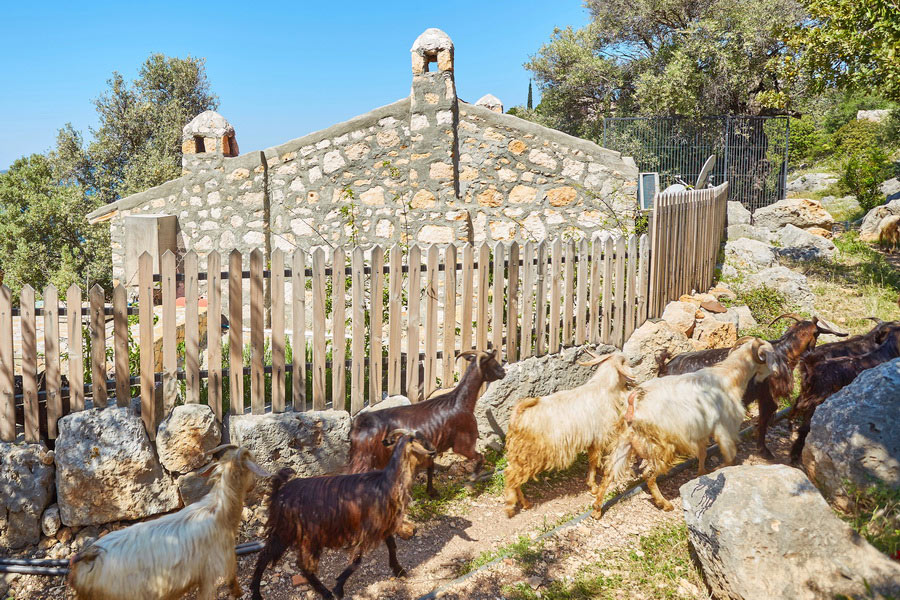
Bordered by the Taurus Mountains, the Turkish Riviera is known for its fertile soil and Mediterranean climate, supporting a diverse range of agricultural activities that attract visitors interested in rural tourism. Citrus groves, particularly in Antalya, are one of the major appeals. Tourists can pick fresh oranges and lemons, enjoy citrus juices, and even take part in cooking classes using local produce.
Kaş, top-tier places to visit in Mediterranean Turkey, is home to several organic farms that practice sustainable agriculture, providing hands-on experiences such as learning biodynamic farming methods, harvesting seasonal crops and eating farm-to-table meals in a natural setting. Meanwhile, Alanya celebrates unique banana plantation tours. Banana production has increased by 139.4% over the past five years, with Mersin and Antalya leading the output. Tours often include visits to greenhouses growing tomatoes, strawberries, and vegetables like aubergines, cucumbers, and peppers, all cultivated using advanced agricultural methods.
Agricultural tours often incorporate historical and cultural sites, such as ancient Myra and the Roman theatre of Aspendos, encompassing Mediterranean Turkey travel with educational experiences. These may also include stops at the Fruit Research Institute (MAREM) in Eğirdir and encounters with nomadic culture near Finike. As visitors explore Turkey's Mediterranean towns and coastal plains, they witness firsthand how agriculture shapes both the economy and the lifestyle of the region.
Embrace Sustainable Shopping: Enjoy Eco-Friendly Finds
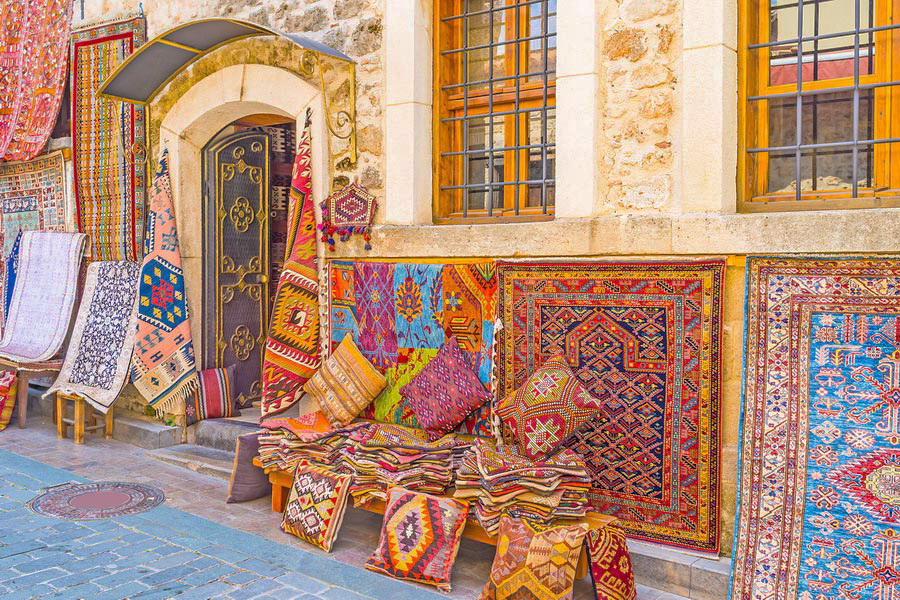
Shopping in the Mediterranean Region of Turkey is a cultural experience which supports sustainability. Antalya's historic Kaleiçi (Old Town) has narrow cobblestone streets filled with small shops selling anything from souvenirs and Turkish carpets to jewellery and antiques. Also in Antalya, the Old Bazaar is a tightly packed series of lanes selling spices, clothing and jewellery.
Adana’s Kazancılar Bazaar (Adana Tarihi Kazancilar Çarşısı) is a living archive of Anatolia’s covered bazaar culture. Once dominated by cauldron and tin makers, it now showcases crafts like wood carving, knife making and embroidery. Tarsus’ Kırkkaşık Bazaar (Kırkkaşık Bedesten), also known as the Bazaar of Forty Spoons, combines Ottoman architecture with modern commerce. Originally built in 1579 as a soup kitchen and madrasah, it now sells local food produces, ceramics and handmade goods.
Shopping in Alanya continues through the night at the Alara Grand Bazaar, where you can find everything from handicrafts to pets like parrots. The Grand Bazaar Shopping Centre sells Turkish coffee and produce. One of the best Mediterranean Turkey shopping experiences is the weekly markets, like the Friday Market (Şekerhane neighbourhood), Tuesday Market (Mahmutlar district) and Sunday Market (Hacet area), trading fresh fruits and vegetables, seafood, textiles and souvenirs to entirely indulge in Mediterranean Turkey Travel.
Surrounded by mosques, churches, and synagogues, Antakya’s Long Bazaar is one of the best places to visit in Mediterranean Turkey, set up by type of work: shoemakers on one street, weavers on another, and metalworkers nearby. Before you leave, make sure to pick up some local favourites like pomegranate syrup, spicy pepper paste, salty yoghurt and the famous cheeses of Antakya.
A Taste of Tradition: Regional Authentic Food of the Turkish Mediterranean Region
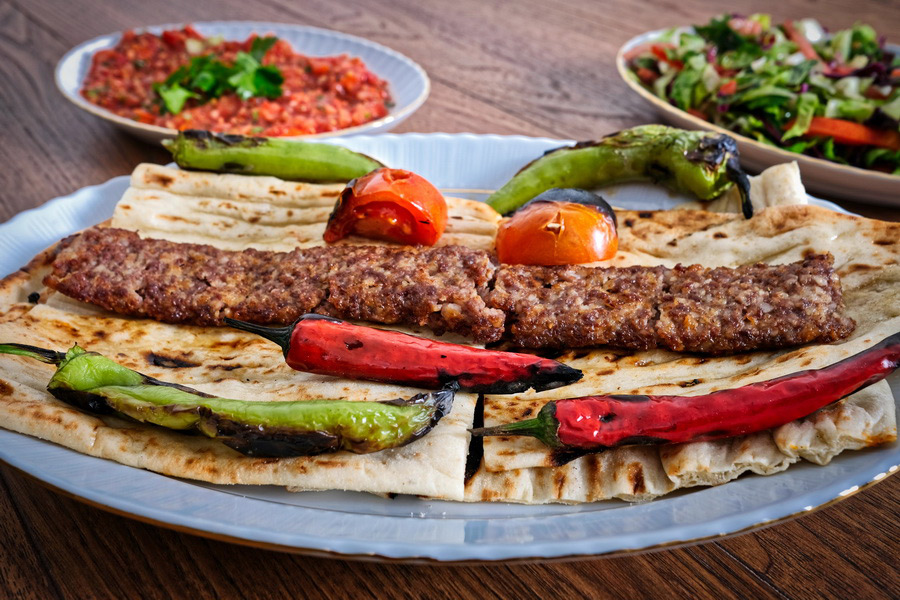
Turkey’s Mediterranean cuisine maintains one of the most appreciated and celebrated culinary traditions in the world, known for its complex and diverse palate. Coming from the use of olives, wheat, fresh vegetables, seafood, meat and dairy, and lots of herbs and spices, the cuisine is divided into three main regions: Eastern Mediterranean, Southern Europe and North Africa.
Antalya, with its greenhouse-based agriculture, one of the best among the Mediterranean foods of Turkey, incorporates a wide array of vegetables and fruits into everyday meals. Dishes like Girit kebabı, laba dolması and hülüklü Çorba, a soup, which highlight the region’s agricultural scene, while citrus jams are primary at breakfast. Alanya bohçası and taratorlu piyaz are just a few examples of how local ingredients are attached with olive oil and herbs.
Homeland of kebabs, Adana is the heartland of spiced and tail fat-enhanced Adana kebabı but is also known for Mediterranean street food such as şırdan and içli köfte. Breakfast also features liver, served with fermented şalgam juice (turnip juice), which together make something special. Bici bici and sarı burma are dessert specialities in Adana.
Tantuni, a wrap of sautéed meat with spices and herbs, is an icon of Mersin. Other local favourites are Tarsus kebabı, batırık, arabaşı Çorbası (soup with meat only), hummus (humus) and a dessert called kerebiç (cookie served with soaproot sauce). Another dessert speciality from Mersin is cezerye, made from carrots and nuts.
The province of Hatay has a cuisine influenced by its shared boundaries with Syria, Adana to the north and Gaziantep to the northwest. Tepsi kebabı, oruk (stuffed balls of bulgur), zahter salad, and firik rice represent the essence of the Mediterranean food of Turkey. Kunefe (bugghetti dessert with a dose of local cheese and soaked in syrup) is the signature dessert of the province of Hatay.
Kahramanmaraş is famous for meat dishes like Maraş tava and a popular local soup, tarhana. The province is also known for its famous dessert, Maraş dondurması (ice cream), which is made from goat milk and salep and has thick, stretchy characteristics. It is served in a unique manner - sliced with a knife.
Enjoy Blooming Festivals of Turkey’s Mediterranean Region

In this sun-soaked region of Turkey, local festivals are closely tied to agricultural cycles, local arts and historical settings, with Mediterranean events in Turkey rooted in local production and tradition.
In Antalya, the Finike Orange Festival (Finike Portakal Festivali) promotes the region’s citrus industry, displaying orange sculptures, culinary showcases and competitions for the best-quality oranges. Another notable festival in Antalya, Sandland is an international sand sculpture festival held every year since 2006. It takes place at Lara Beach, covering 7,000–10,000 m², with a new theme each year. Artists from around the world create large sand sculptures, which last for about 12 months and are lit up at night.
The Isparta Rose Festival (Isparta Gül Festivali) draws attention to the region’s famed rose harvest, with activities like rose-picking, oil production demonstrations and cultural performances. Meanwhile, Burdur’s International Salda Lake Festival (Salda Gölü'nde "Doğa Festivali"), brings together folk dance, theatre and music groups for multicultural exchanges, with performances near the stunning Salda Lake.
The Antalya Golden Orange Film Festival (Antalya Altın Portakal Film Festivali) exhibits international and national films, while Adana’s Golden Boll Film Festival (Adana Altın Koza Film Festivali) puts forward workshops and screenings alongside regional culinary experiences. Mersin International Music Festival (Uluslararası Mersin Müzik Festivali) spotlighting orchestras and soloists from Turkey, Europe and Asia, with performances at historic venues of St. Paulus Church and Kanlıdivane. Side International Culture and Art Festival (Side, Uluslararası Kültür ve Sanat Festivali) grants free concerts and dance performances at the Side Ancient Theatre and Temple of Apollo during your Mediterranean Turkey travel.
How to Reach the Sun-Drenched Mediterranean Region of Turkey
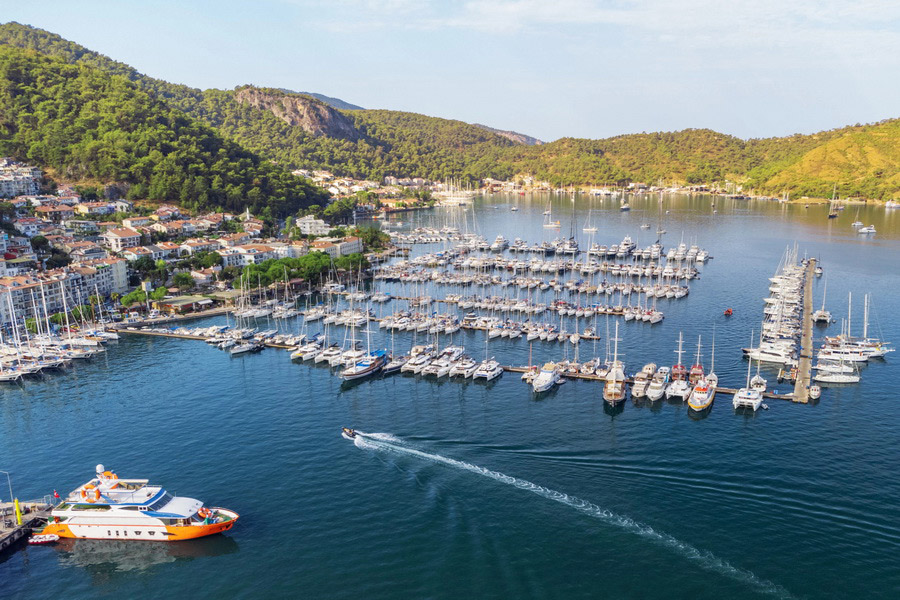
Getting to the Turkish Mediterranean Region is varying from affordable to high-end options. Some visitors like the convenience of an international flight, while others prefer the elegance of sailing in. The southern coast of Turkey awaits visitors looking for beauty and sophistication.
By Sea
The most glamorous way to arrive in the Turkish Mediterranean is to get there by sea. The Turkish Riviera is a sailing paradise, where Mediterranean cruise liners, mega-yachts, and sleek catamarans take off daily from Greece, Italy, France, Croatia and beyond.
- Antalya Port, Alanya Cruise Port, Fethiye Marina, and the elite Göcek and Kaş Marinas host a constant parade of luxury vessels. These modern ports provide access to customs clearance, fuel stations, fine-dining harbourside restaurants and even helicopter landing pads.
- The Blue Voyage (Mavi Yolculuk) tradition continues here, inviting guests aboard traditional wooden gulets, reconstructed with Jacuzzis, sun decks and private chefs, and sailing from Bodrum to Kekova or Göcek to Olympos, often stopping at Butterfly Valley or Gemiler Island.
Key Routes
- Antalya to Kaş: 3 hours by road or 2.5 by private yacht
- Dalaman to Göcek: 25 minutes by car or 15 minutes by private transfer boat
- Bodrum to Fethiye via yacht: 5–7 days of coastal exploration
- Rhodes to Fethiye ferry: 90 minutes (seasonal, for travellers combining Greek Isles with Turkish Riviera)
- Cannes to Antalya by luxury cruise: 10–14 day Mediterranean itineraries offered by Silversea, Seabourn, and AzamaraBy Air
Major Airports: Antalya Airport | Dalaman Airport
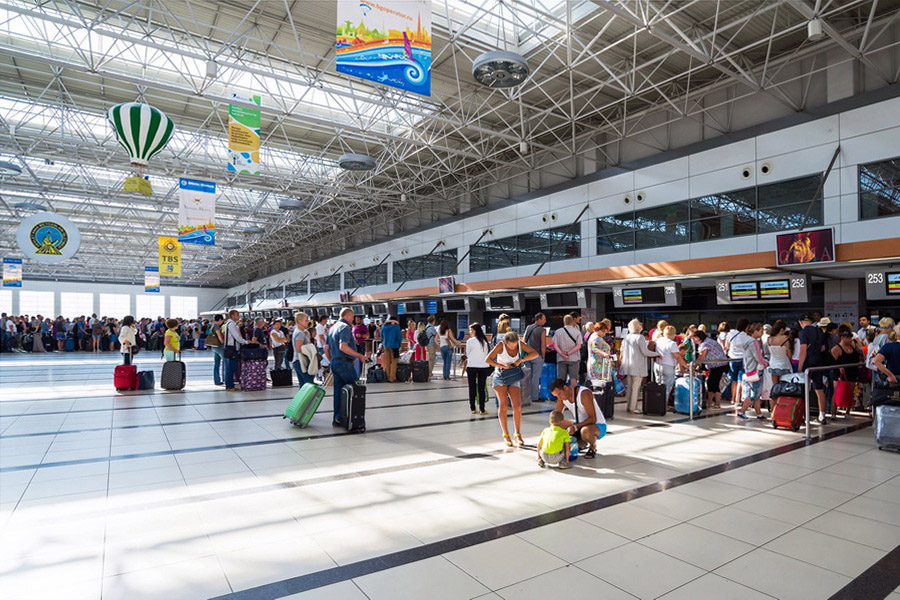
The region’s two primary airports, Antalya Airport (AYT) and Dalaman Airport (DLM), welcome travellers from around the world. Antalya is Turkey’s second-busiest international airport during summer, with direct flights from London, Berlin, Dubai and Amsterdam, as well as dozens of chartered jets and seasonal airlines.
- Dalaman Airport is favoured by luxury travellers heading to Göcek, Fethiye, and Kalkan, and all are under one hour's drive.
- Private jet terminals are available in Antalya and Dalaman for discreet, high-end entry.
- Helicopter charters and seaplanes transfers between Antalya and coastal resorts (Bodrum, Belek, Fethiye, Kaş, Kemer, Marmaris), Pamukkale and Cappadocia can be arranged via Royal Fly or luxury Mediterranean resorts in Turkey.
By Road
For overland explorers, highways from Istanbul (10 hours) or Ankara (7 hours) lead you through citrus groves and olive-studded hills into coastal Turkey Mediterranean towns like Adrasan, Finike and Anamur. A road trip here is a prelude to seaside paradise.
Luxury car rentals, chauffeur-driven vehicles, and even vintage convertible tours are popular for guests staying in secluded boutique hotels along the Lycian Way.
By Bus
Major cities like Antalya, Mersin, and Fethiye are connected to Istanbul, Ankara, and Izmir via comfortable and cost-efficient overnight buses.
While not the most luxurious experience, companies like Metro Turizm and Kamil Koç have reclining seats, snacks and Wi-Fi. Journeys take 10–13 hours and cost around $25 to$50 (€21 to €43 and £18 to £37).


